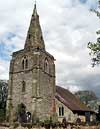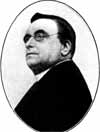 Scarrington Scarrington
St John of Beverley
History
The village itself is listed in the Domesday Book as Scarintone. Archaeological evidence suggests that a community has lived here since pre-Roman times. There is no mention of the church in Domesday, however, and no record as to when it was first built.
The church is Grade I listed and consists of a chancel (with organ chamber/vestry on the north side), nave, south aisle and west tower with a spire.
The steeple was described by Pevsner (2020) as being a ‘typical Nottinghamshire spire, not too steep and not too tall’. It has three tiers of dormer windows (lucarnes). The early 14th century date of the tower is indicated by the ballflower ornament of the west door and the two-light window above it. The south arcade also dates from the same period.
In 1364 one John Kent of Scarrington was, with many other local men, accused by the prior of the Hospital of St John of Jerusalem in England (the Knights Hospitaller) that he carried away his goods at Swinderby (Lincolnshire) and assaulted the prior’s bondmen and servants. No reason is given for this action but a commission of oyer and terminer (an official legal enquiry) was ordered by King Edward III.
Scarrington was a chapelry of nearby Orston until 1867. At this point, it was detached and united with Aslockton (detached from Whatton) to form a new ecclesiastical parish. This had been an outcome recommended 217 years earlier by Parliamentary Commissioners!
Archbishop Thomas Cranmer, who was born at nearby Aslockton in 1489, may have worshipped at the church during his early years.
Scarrington was badly affected from the religious reforms of the 16th century. A record in 1559 notes that the benefice was ‘void’ and the church’s ‘books burnt’ by the official.
In 1567, Thomas Shipman of Scarrington, gentleman, left £5 for the repair of the church.
In 1632, a second Thomas Shipman was baptised in the church. He would go on to author the volume Carolina: or Loyal Poems which was posthumously printed and sold in London in 1683. Shipman was buried at Scarrington following his death in October 1680.
The small font dates from 1662 and is located under the tower. The design on the bowl is similar in appearance to that at Sibthorbe (1662) and at Southwell Minster (1661), the latter being made by William Balme of Mansfield. The original church font was recovered in 1900 having been used as a pump trough for many years. It now sits at the east end of the south aisle.
In 1730 a clandestime marriage conducted by the Rev. Joshua Hemingway of Orston was reported when he was presented to the Archdeaconry of Nottingham court by Thomas Hebblethwaite, curate of Whatton, for ‘marrying Robert Palfreyman of Grantham and Elizabeth Flower of Aslockton in the parish of Whatton, in his own church at Scarrington without certificate or licence from Hebblethwaite or a licence from the Ordinary.’
No separate return for Scarrington was made at the time of Archbishop Herring’s Visitation in 1743; it was simply noted that, along with Thoroton, it was a chapel of Orston.
The return for the parish of Orston at Archbishop Drummond's Visitation in 1764 includes the statement: 'There are two churches appendages to Orston viz. Thoroton and Scarrington, the mother church Orston, is served every Sunday and the other two alternately once a fortnight.'
In October 1753 a Scarrington churchwarden presented William Growcock ‘for turning his swine into the chapel yard and suffering them to root up the ground or soil therein.’
In 1790, the tower and spire were rebuilt.
Two documents relating to proposals for work on the church fabric dating from the 1790s survive in the records of the Archdeaconry of Nottingham: one is a citation with intimation, and draft faculty for taking down and rebuilding Scarrington chancel (1792); the other is a citation for faculty, special proxy to issue citation for faculty, and draft faculty for taking down the south aisle, re-pewing, and building a gallery in Scarrington chapel (1795).
The Religious Census of 1851 recorded that Scarrington was a chapel of ease of Orston. It had an average congregation of 60, meeting alternately in the morning, afternoon and evening.
Sir Stephen R. Glynne visited the church in April 1866. He described it as being:
‘A small and rather poor church, much out of condition, consisting of nave and chancel only, with a west tower and spire. There seems to have been once a south aisle, now destroyed, and the arcade may be distinguished in the south wall now rebuilt in brick. The arches are pointed upon octagonal pillars. There is no arch to the chancel or any division. The church is pewed. East window has been smashed—those on north of nave are Perpendicular, one square headed and labelled: those on south are modern, as also the wall. The roof is ceiled. The chancel has an original south doorway with hood. There is an oblong recess in wall on the south of chancel. Font is small, and apparently 17th century. The tower is Decorated, rather heavy and has flat buttresses which may be Early English. The west doorway has two orders of mouldings, the outer having the ball flower, the inner square flowers and no shafts. The second stage has a plain Early Decorated window of two lights without foliation. The belfry windows are large but mutilated. The parapet is plain, the spire octagonal without ribs, having two tiers of single spire lights set in the same sides.'
In February 1867, by Order in Council, the chapelry of Scarrington was detached from the vicarage of Orston and the chapelry of Aslockton was detached from the vicarage of Whatton. The two detached chapelries were united to form the new vicarage of Scarrington-with-Aslockton and on 12 April 1867 the Rev Alfred Pavey was instituted and admitted as the first incumbent of the united parishes. There was, apparently, ‘some opposition to the scheme for amalgamating the two parishes’.
However, Scarrington church was too small to accommodate the parishioners of Aslockton as well as the normal congregation and was in a dilapidated condition so the Rev A. Pavey embarked on a project to restore and extend the building. The work was undertaken during the second half of 1867, supervised by the architect J. H. Hakewill of London. A south aisle was added which involved unblocking the 13th century south arcade which had been bricked up c.1800 when the medieval aisle was demolished. An organ chamber was added to the north wall of the chancel (though no organ was installed at the time), the chancel was ‘effectively restored’, the old pews and pulpit were replaced, new stalls and lectern provided and three stained glass windows by Ward and Hughes of London were installed in the chancel and nave.
The reopening on 17 December 1867 was celebrated with a morning service led by the Bishop of Lincoln. However, a few days prior to the reopening the furnace at the west end of the church over-heated after the workmen had departed for the day and ignited a heap of coals lying nearby. Fortunately, the fire did not spread to the new stalls a short distance away and disaster was averted.
In 1896 the spire was completely rebuilt, the tracery in the belfry openings was replaced and the parapet and buttresses repaired. The work cost £500.
According to popular legend, there was an interesting occurrence in the 19th century involving the Scarrington ‘ghost’. Two apprentices went up into the belfry, tied a piece of coco binding around the clapper of one of the bells, and took it across the way into Colin’s Yard where they waited until nightfall. After dark, they sat at the top of the stack and pulled the clapper. Upon hearing the sound, the vicar awoke, lit a lantern and went up into the tower, alongside the clerk and another man, to investigate. As soon as the boys saw the light in the tower they stopped pulling and the party came down. As soon as they had got down the bell rang again and so on until the group of men did not dare alight the tower for fear of what they might find. The joke was kept for three nights until the binding broke and was found in a lane nearby.
 The Rev John The Rev John
Standish |
In 1912, the vicar was the Rev John Standish. The net annual value of the benefice was £270. The parish population in 1911 was 543; it had been 550 in 1901. Scarrington church could accommodate 200 worshippers. There were 64 children on the books for the day school and 15 for the Sunday School. There were five baptisms in the year ending 30 September 1912 and three confirmations.
In 1922, Kelly’s Directory of Nottinghamshire noted that the living was a vicarage with the rectory of Hawksworth annexed. It had a joint net yearly value of £400 with a residence. The patrons were listed as the Dean and Chapter of Lincoln. The alternative patron was one Mr Bayles.
The roof was re-tiled in 1956.
The church made national news in 1957 when the League Against Cruel Sports protested to the Bishop of Southwell after a hunting horn was sounded and a severed fox tail thrown into the grave at the funeral of the Master of the South Nottinghamshire Hunt, Captain T. Readett-Bayley who had been killed in a car accident.
The tower was repaired again in 1960.
Scarrington St John has been part of the Cramner Group of parishes since 1967. The group comprises the parishes of Aslockton, Hawksworth, Orston, Scarrington, Thoroton and Whatton.
A major project was undertaken in 2002 to replace the wooden bellframe with a metal one which could accommodate six bells. The three original late medieval bells were refurbished, re-hung and a fourth bell donated.
In 2004 a Ringers Gallery was installed in the tower, accessed by a new doorway from the spiral staircase. A fifth bell was acquired through the Keltec Trust.
A sixth bell was donated to the church by the Southwell Diocesan Guild of Church Bell Ringers in 2007.
|